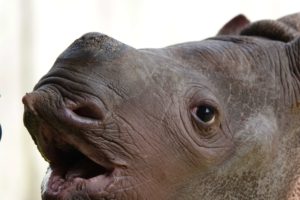White Oak Conservation
Media Release
March 9, 2019 10:00 a.m.
Births of southern black rhino, greater one-horned rhino part of global conservation efforts

Yulee, Fla. (March 6, 2019) — It’s a baby boom at White Oak Conservation: Two rhinos were born weeks apart this winter and are being raised at the 17,000-acre wildlife refuge owned by philanthropists, Mark and Kimbra Walter.
Rhino baby No. 1 is Tidbit, the first southern black rhino born at White Oak in 13 years. When he was born in early November, he was underweight and too small to reach his mother to nurse. He began to weaken quickly, so the wildlife specialists at White Oak intervened and decided to hand-rear and bottle-feed Tidbit.
Tidbit is fed a milk matched to rhinos’ milk, which includes skim and 1 percent cows’ milk. Hand-raised animals are often more at risk for medical challenges while young, so the veterinarians and animal teams at White Oak are paying extra attention to Tidbit’s development and weight gain.

Recently, Tidbit got a newborn, critically endangered mountain bongo calf as a buddy. Both animals will live together while they are young and benefit from each other’s companionship. The pair has room to play outside together, and if it’s chilly, they have a heated barn to share.
Rhino baby No. 2 was born in late December. Kali is a greater one-horned rhino, also known as an Indian rhino. Kali was the first calf for her mother, Shomili, who came to White Oak two years ago from San Diego Zoo Safari Park.
Southern black rhinos like Tidbit are native to Africa and are classified as “critically endangered” in the wild. Greater one-horned rhinos like Kali are native to India and Nepal are classified as “vulnerable.” The greatest threat to all rhinos is poachers. About every eight hours a rhino is killed for its horns, which are in high demand as status symbols in China and Vietnam and also are used in traditional Asian medicine.
“Their use as a prestigious gift for parties shows total indifference to this great animal and its extinction,” said Mark Walter, White Oak’s owner. “My wife and I will continue to do everything we can to protect these animals until the poaching is materially diminished and the populations rise again, but we will not succeed unless the Chinese government does all it can to crack down on the criminal networks financing the trade.”
The Walters own or co-own hundreds of thousands of acres of reserves in Africa, where they fund anti-poaching efforts. Their teams track and monitor rhinos; rehabilitate injured rhinos; move them from high-risk areas; and work with local communities to build support for their safety.
With large habitats surrounded by almost 17,000 acres of quiet forest, White Oak provides a protected home in the northeast corner of Florida for three of the five rhino species: black, white and Indian rhinos. Rhinos first came to White Oak in 1985. Black rhinos from Zimbabwe were brought to White Oak in 1993 to start a breeding program in case the wild population was lost. The Indian rhinos came later.
White Oak manages its rhino species as a critical part of collaborative species conservation plans. These plans guide White Oak and its partners as they support conservation efforts and build a sustainable North American population of rhinos as an assurance, or backup, population.
“Given the unabated poaching crisis, every rhino birth is precious,” said White Oak CEO Steve Shurter. “These two rhino calves are valuable additions that support White Oak’s efforts to sustain and secure an assurance population of rhinos.”
Today, White Oak also is launching Rhinogram, a free, monthly emailed newsletter. Those who sign up at www.whiteoakwildlife.org/rhinogram will get monthly photos, videos and updates about all of the rhinos of White Oak Conservation.
Facts about black rhinos
· In the wild, they live primarily in South Africa and Zimbabwe.
· They are classified as “critically endangered” by the IUCN Red List.
· They have two horns.
· One distinguishing feature is their hooked upper lip.
· They eat leaves from bushes and trees.
· By 1993, just 2,300 remained in the wild, down from approximately 65,000 in 1970.
· Thanks to sustained conservation efforts, that number today is around 5,000.
Facts about Indian rhinos
· Their official name is the greater one-horned rhino.
· In the wild, they live in Nepal and India.
· They are classified as a “vulnerable” species by the IUCN Red List.
· Their grey-brown hide is marked by skin folds, giving an armor-plated appearance.
· They have one horn, 8-25 inches long.
· They eat grasses, leaves, branches of shrubs and trees, fruit and aquatic plants.
· Earlier in the 20th Century, fewer than 200 remained in the wild.
· Through conservation efforts, the populations in the wild now number about 3,550.
Facts about mountain bongo
· They are a forest antelope.
· In the wild, they live in central Kenya.
· Only 70-80 adult mountain bongo are estimated to remain in the wild; they are critically endangered.
· They live in dense, humid mountain forests.
· More than 130 mountain bongo calves have been born at White Oak in the last 25 years.
· White Oak has assisted in the repatriation of mountain bongo from the U.S. to Kenya.
About White Oak Conservation
White Oak Conservation works to save endangered species and wild places. White Oak leads global conservation through innovative science, education, training, and collaborations. We are committed to providing conservation options for many of the species that need them the most. White Oak’s 17,000 riverfront acres in northeast Florida provide a refuge for more than 17 different endangered species. Additionally, White Oak works to help and inspire others to support conservation by hosting education, conservation, corporate and family groups for visits, overnight stays, conferences, and meetings. We are an Association of Zoos & Aquariums (AZA) certified facility. White Oak is owned by philanthropists Mark and Kimbra Walter. www.whiteoakwildlife.org
